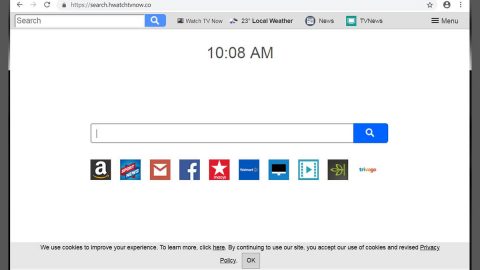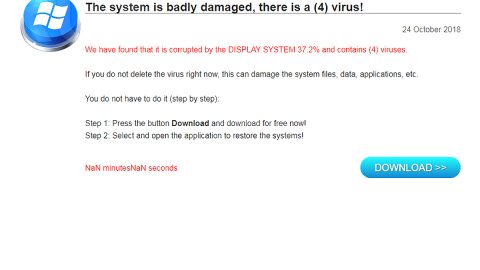What is LockCrypt ransomware? And how does it implement its attack?
LockCrypt ransomware, also known as .mich file virus as it appends the .mich extension to its encrypted files, is a file-encrypting virus which was first discovered on December 2017. By the looks of it, it’s now back with a new and improved version that keeps on initiating brute-force attacks via Remote Desktop Services. Once it is able to gain access to the targeted PC, it will look for various kinds of files to encrypt which according to security experts are files containing these extensions:
.incpas, .mp4, .pab, .st6, .sas7bdat, .wmv, .backup, .drf, .ibank, .3ds, .odg, .cer, .tif, .cs, .dotx, .7z, .png, .bak, .ibz, .db3, .pbl, .3fr, .dxf, .nk2, .bkp, .mdf, .svg, .xlm, .3dm, .pct, .java, .pot, .sxi, .ibd, .sxw, .pspimage, .ppt, .kbx, .ppsm, .ndd, .txt, .pdb, .say, .backupdb, .fla, .swf, .asx, .accdt, .mp3, .ycbcra, .erf, .cr2, .pfx, .potx, .qby, .sqlite, .blend, .class, .pat, .odp, .gray, .qbw, .tib, .thm, .htm, .mos, .rm, .key, .std, .tlg, .lua, .pst, .sqlitedb, .grey, .cdr4, .dc2, .ce1, .ps, .tex, .eml, .xlam, .pages, .st8, .jar, .st7, .potm, .sdf, .db-journal, .pcd, .aspx, .rwl, .kpdx, .fmb, .xlr, .gry, .kc2, .oil, .moneywell, .xlk, .sti, .accdr, .oth, .c, .xml, .nd, .mdb, .pem, .erbsql, .bpw, .ffd, .ost, .pptm, .dwg, .zip, .qbm, .cdx, .des, .dng, .pdd, .cfp, .nyf, .cgm, .sldm, .xla, .odf, .raf, .crw, .mef, .raw, .x11, .nsd, .fff, .design, .dcs, .ptx, .al, .ns2, .bik, .back, .accdb, .nwb, .cpi, .ads, .odt, .sqlite3, .docm, .drw, .pl, .nx2, .fpx, .rdb, .otp, .msg, .accde, .agdl, .php, .csv, .py, .rtf, .ach, .sda, .ddd, .asf, .dotm, .cmt, .h, .hbk, .xlsx, .s3db, .tga, .wav, .iif, .dxb, .sql, .db, .sd0, .bgt, .djvu, .jpg, .doc, .craw, .mpg, .sxd, .kdc, .jpeg, .psafe3, .flac, .dtd, .act, .qba, .vob, .cdrw, .eps, .bkf, .mdc, .rar, .mov, .cdf, .m4v, .ab4, .bank, .pps, .cib, .dot, .dgc, .exf, .flv, .xlsb, .ddrw, .adb, .srw, .plc, .csh, .xls, .fxg, .otg, .pas, .xlt, .indd, .rwz, .xltx
These listed file types are only half of what LockCrypt ransomware can encrypt which makes it different and more dangerous than a typical ransomware infection. Once it finds the files it’s looking for, it will begin the encryption process and append the .mich extension or the .lock or .1btc extensions to the encrypted files. Following data encryption, LockCrypt ransomware delivers its ransom note that contains the following content:
“All your files have been encrypted due to the security problem with your PC. If you want to restore them, write us to the e-mail support: [email protected] or [email protected]
Write this ID in the title of your message
In case of no answer in 24 hours write us to these e-mails support: [email protected] or [email protected]
You have to pay for decryption in Bitcoins. The price dependson how fast you write to us.”
How does LockCrypt ransomware proliferate?
As pointed out earlier, LockCrypt ransomware proliferates using brute force attacks on the targeted PC by taking advantage of unsecured Remote Desktop services. Aside from that, this ransomware might also employ spam emails and attach corrupted files to them containing the malicious payload.
Refer to the removal guide provided below to obliterate LockCrypt ransomware and its malicious components from the infected PC.
Step 1: Restart your PC and boot into Safe Mode with Command Prompt by pressing F8 a couple of times until the Advanced Options menu appears.

Step 2: Navigate to Safe Mode with Command Prompt using the arrow keys on your keyboard. After selecting Safe Mode with Command Prompt hit Enter.
Step 3: After loading the Command Prompt type cd restore and hit Enter.

Step 4: After cd restore, type in rstrui.exe and hit Enter.

Step 5: A new window will appear, and then click Next.

Step 6: Select any of the Restore Points on the list and click Next. This will restore your computer to its previous state before being infected with the LockCrypt Ransomware. A dialog box will appear and then click Yes.

Step 7: After System Restore has been completed, try to enable the disabled Windows services.
- Press Win + R keys to launch Run.
- Type in gpedit.msc in the box and press Enter to open Group Policy.
- Under Group Policy, navigate to:
- User Configuration\Administrative Templates\System
- After that, open Prevent access to the command prompt.
- Select Disable to enable cmd
- Click the OK button
- After that, go to:
- Configuration\Administrative Templates\System
- Double click on the Prevent Access to registry editing tools.
- Choose Disabled and click OK.
- Navigate to :
- User Configuration\Administrative Templates\System>Ctrl+Alt+Del Options
- Double click on Remove Task Manager.
- And then set its value to Disabled.
Step 8: Open Task Manager by pressing Ctrl + Shift + Esc at the same time. Proceed to the Processes tab and look for the malicious processes of LockCrypt Ransomware such as “SF.exe”, “TR.exe” or “BLACKROUTER.exe” and end them all.

Step 9: Open Control Panel by pressing Start key + R to launch Run and type appwiz.cpl in the search box and click OK to open the list of installed programs. From there, look for LockCrypt ransomware or any malicious program and then Uninstall it.
Step 10: Tap Windows + E keys to open the File Explorer then navigate to the following directories and delete the malicious files created by LockCrypt ransomware such as ReadMe.txt.
- %USERPROFILE%\Downloads
- %USERPROFILE%\Desktop
- %TEMP%
Step 11: Close the File Explorer.
Before you proceed to the next steps below, make sure that you are tech savvy enough to the point where you know exactly how to use and navigate your computer’s Registry. Keep in mind that any changes you make will highly impact your computer. To save you the trouble and time, you can just use [product-name] this system tool is proven to be safe and excellent enough that hackers won’t be able to hack into it. But if you can manage Windows Registry well, then, by all means, go on to the next steps.
Step 12: Tap Win + R to open Run and then type in regedit in the field and tap enter to pull up Windows Registry.

Step 13: Navigate to the paths listed below and delete all the registry values added by LockCrypt ransomware.
- HKEY_CURRENT_USER\Control Panel\Desktop\
- HKEY_USERS\.DEFAULT\Control Panel\Desktop\
- HKEY_LOCAL_MACHINE\Software\Microsoft\Windows\CurrentVersion\Run
- HKEY_CURRENT_USER\Software\Microsoft\Windows\CurrentVersion\Run
- HKEY_LOCAL_MACHINE\Software\Microsoft\Windows\CurrentVersion\RunOnce
- HKEY_CURRENT_USER\Software\Microsoft\Windows\CurrentVersion\RunOnce
Step 14: Close the Registry Editor and empty your Recycle Bin.
You have to continue the LockCrypt ransomware removal process using a reliable program like [product-name] once you’re done with the steps given above. How? Follow the advanced removal steps below.
Perform a full system scan using [product-code]. To do so, follow these steps:
- Turn on your computer. If it’s already on, you have to reboot
- After that, the BIOS screen will be displayed, but if Windows pops up instead, reboot your computer and try again. Once you’re on the BIOS screen, repeat pressing F8, by doing so the Advanced Option shows up.
- To navigate the Advanced Option use the arrow keys and select Safe Mode with Networking then hit
- Windows will now load the SafeMode with Networking.
- Press and hold both R key and Windows key.
- If done correctly, the Windows Run Box will show up.
- Type in the URL address, [product-url] in the Run dialog box and then tap Enter or click OK.
- After that, it will download the program. Wait for the download to finish and then open the launcher to install the program.
- Once the installation process is completed, run [product-code] to perform a full system scan.
















